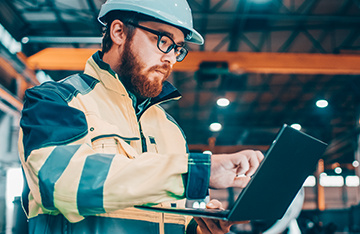- Home
- Equipment Rental
Equipment Rental Software
Drive equipment rental success with AI-enabled ERP
ALREADY TRUSTED BY


-1.png)


Discover how our Equipment Rental Software simplifies your business

“Ainscough Crane Hire has grown its revenue significantly and consistently every year since 2020. This has been enabled by a deep understanding of the end-to-end transactional and customer order data. This could not have been achieved without the implementation of D365 F&SCM and the STAEDEAN Equipment Rental modules”.
Ian O’Reilly
IT & Transformation Director
Features
The STAEDEAN equipment rental solution seamlessly adapts to any industry or business model, easily addressing your unique business requirements. Experience accelerated growth with a versatile solution offering robust features to manage your industry-specific rental operations and ensure secure and organized data.
Scroll to
Fleet Management

Fleet Management
Effortlessly manage your global rental fleet, meet regulatory compliance, maximize utilization, track ownership, and cut costs.
Key challenges we solve:
- Regulatory and safety compliance
- Equipment rental downtime
- Misallocating cost and revenue
Asset Management

Asset Management
Optimize asset utilization and reduce ownership costs by tracking locations, maintenance, availability, and contracts efficiently.
Key challenges we solve:
- Underutilized rental assets
- Missed reservations and bookings
- Inefficient lifecycle management
Complex Pricing & Invoicing

Complex Pricing & Invoicing
Simplify pricing, offer competitive rates, automate billing, manage multiple revenue streams, and cruise ahead of the competition.
Key challenges we solve:
- Delays in generating quotes
- Inability to handle flexible pricing
- Low revenue and cash flow
Supply Chain Management

Supply Chain Management
Gain complete supply chain visibility to boost equipment use, deliver timely, speed up order fulfillment, and strengthen logistics.
Key challenges we solve:
- Frequent material stockouts
- Excess holding costs
- Lags in delivery and return
Service & Maintenance

Service & Maintenance
Maximize the uptime of your equipment by executing on-site or off-site maintenance and service in a timely and efficient manner.
Key challenges we solve:
- Increased downtime
- Equipment safety risks
- High maintenance expenses
Planning & Dispatching

Planning & Dispatching
Streamline planning by scheduling and monitoring regional and global resources and equipment across rental contracts and projects.
Key challenges we solve:
- Increased idle time
- High operational costs
- Mismanaged inventory
Inventory Management

Inventory Management
Easily manage serialized and bulk rental inventory to optimally source, store, track, schedule, maintain, and reuse your equipment.
Key challenges we solve:
- Inaccurate planning
- Poor resource management
- Inability to track equipment
Accounting

Accounting
Simplify finance management, enhance decision-making, cut costs, and ensure regulatory compliance with total visibility into assets.
Key challenges we solve:
- Long collection cycle
- Managing accounts payable
- Fixed asset management
- Enhance project management with maximized planning efficiency, complete project visibility, controlled costs, and improved interdepartmental collaboration.
- Migrate data and configure unlimited integrations between third-party systems and Microsoft Dynamics 365 F&SCM with a no-code, point-and-click method.
- Simplify data modeling, cleaning, preparation, transformation, and extraction to derive meaningful, data-driven insights to strengthen business strategy.
- Accelerate time to value with pre-configured and documented procedures using standard templates to speed up implementation and reduce costs.

Industries we serve
Cranes

Oil and Gas

Heavy Equipment and Construction

High Tech and Medical

Truck and Trailer

Explore our Equipment Rental Software Packages
Project Driven
Sales Driven
Service Driven
Manufacturing Driven
Optimize each stage in the equipment rental value chain
Rental Ready

Manage lead-to-cash, competitive pricing, and complex contracts
Stay ahead by monitoring converting quotes and adapting offerings to gain a competitive advantage. Manage agreements and conduct equipment availability checks to fulfill customer rental orders promptly.
Efficiently handle customer contracts, ensuring equipment readiness through calibration, dismantling, packing, and attachment, guaranteeing timely dispatch.
On-Rent

Maximize efficiency of equipment operations
When your equipment is on rent, it is crucial to employ cutting-edge technology such as IoT for real-time monitoring of usage and BI for comprehensive financial tracking.
Rental revenue depends on duration, rates, demand, and equipment value. Stay on top of your income and Days Sales Outstanding (DSO) to optimize performance during each rental cycle. Additionally, you can support equipment installation and maintenance during the rental period and flexibly adjust the contract duration or equipment choices based on mutual agreements with customers.
Off-Rent

Transfer equipment to the depot and optimize readiness
Effortlessly manage equipment pick-up, inspection, and relocation. Define key metrics for assessing equipment performance during the rental period.
Streamline equipment preparation for future rentals, prioritizing safety, which includes mass returns, inspections, billing, and credits. Utilize inspection checklists to assess equipment condition and invoice accordingly.
Workshop and Maintenance

Minimize asset downtime and maintenance expenses
Monitor breakdowns and service needs while gauging overall equipment effectiveness and maintenance expenses. Assess comprehensive insurance and warranty information for all assets, ensuring complete coverage.
Leverage an AI-enabled mobile field service app built on Microsoft Power Platform to reduce the field staff's workload and offer remote access to data for prompt repairs. Uphold peak performance standards by meticulously recording equipment quality and safety checks to execute timely maintenance jobs, including preventive, corrective, and emergency servicing.
Operational Fleet

Manage end-to-end rental operations
Maintain top-notch quality standards for your rental and transport fleet, guaranteeing safety through regular inspections. Ensure availability across key depots or regions globally and optimize their movement to swiftly and effectively meet customer demands.
The success rate in this stage depends upon equipment performance throughout the other stages and directly impacts your rental business's cost, efficiency, and overall operational success.
Resources
Scroll to






 Thomas Sonnichsen
Thomas Sonnichsen

 Anastasia van der Wielen
Anastasia van der Wielen

